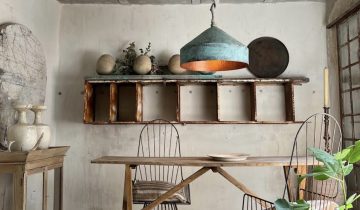After I met Will Zhang at a design show, I couldn’t stop thinking about his no-holds-barred passion for hardware. Hardware is often the afterthought in a renovation, he told me. But as something we encounter innumerable times on a daily basis, it shouldn’t be.
An industrial designer by training, now the director of design and product innovation at LA-based hardware co. Emtek, Will believes doorknobs, cabinet pulls, knobs, levers, and handles are among the most important details in a house. To design them, he thinks like both an artist and an engineer, finding aesthetic inspiration while biking in Italy (artist) and considering the disproportionate difference that a smart switch of door hardware can make in a tiny space (engineer).
Back home from the design show, I emailed Will to mine his expertise—and get a handle (sorry) on how we can all make better hardware choices. Here’s our Q+A.
Photography courtesy of Emtek, except where noted.
Remodelista: How did you get into designing hardware?
Will Zhang: I was curious from an early age. I spent a lot of time exploring my imagination, and like a monkey drawn to shiny objects, I was fascinated by the details in old Jaguar and Mercedes parts from my father’s car restoration projects. Those intricate elements—dashboards, door handles, the way materials came together—sparked my curiosity about the people behind the designs and the thought process that shaped them.
I’ve always had a deep creative drive and an instinct for aesthetics, which I initially expressed through fashion and art. But it wasn’t until my twenties that I decided to turn that passion into a career. I pursued a degree in Industrial Design, ultimately leading me to Emtek, where I became the company’s first formal designer. It was a hands-on, learn-as-you-go experience.
RM: You mentioned that you find inspiration in unexpected places. Can you share an example that’s led to a design?
WZ: I spend a lot of time lost in thought, letting ideas drift and evolve. Not everything turns into something tangible, but it all feeds into my approach as a designer. A few years ago, I was cycling through the Alps in northern Italy, pushing through some of the steepest, most breathtaking terrain I’ve ever ridden. During one of those climbs, I spent a good amount of time admiring the cliffside striations running alongside the road. That texture stuck with me, and later, I incorporated it into a pull design, one that ended up being manufactured in the same region of Italy that we named “Stradella” after its inspiration.

RM: Why is paying attention to hardware important?
WZ: Hardware is the jewelry of a home’s design, so why wouldn’t it be treated that way? It’s a bit ironic though, because while jewelry is valuable and meant to be seen, we don’t usually build our outfits around it. With hardware, it’s the opposite. It’s not just about aesthetics but also touch and function, making it an essential part of how you experience a space. I think we’re starting to see more designers take a more elevated approach to hardware, incorporating statement pieces on kitchen cabinets or exploring unique formats like edge pulls and longer cabinet pulls that integrate seamlessly.
RM: What’s something people don’t think about when choosing hardware, but should?
WZ: For doors, instead of defaulting to one finish throughout the home, consider using split finishes to define different areas. For example, polished nickel in a bathroom can enhance a clean and refined aesthetic, while satin brass in a hallway adds warmth and character. Thoughtful combinations like these elevate the overall design and help hardware feel integrated rather than an afterthought.
For cabinets, scale and proportion play a huge role in making hardware feel intentional. Using the same pull length across all cabinets might seem like the easiest choice, but adjusting pull sizes based on the scale of the cabinet fronts creates a more cohesive and balanced and, IMO, custom look.
RM: And a common pitfall?
WZ: One of the biggest mistakes people make with hardware is not consulting a professional or trade expert for insight before making a decision. There is an overwhelming number of options available, and hardware plays a bigger role in design and functionality than most people realize. Why not take advantage of the expertise of those who live and breathe this category? They can help guide selections to ensure that the hardware not only looks great but also functions seamlessly. Thoughtful choices can make a home feel more elevated, cohesive, and even unique.
At the end of the day, hardware is one of the first things you touch when you enter your home, it should be just as considered as any other design element.





